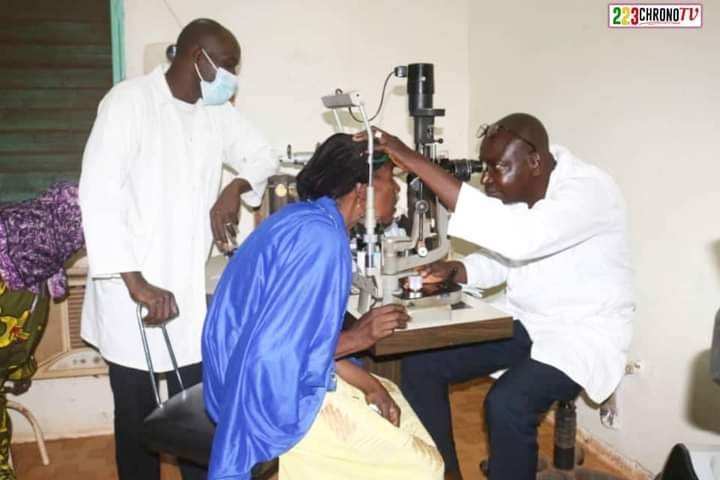
From 05 to 08 October 2024, 200 elderly people in Sikasso who do not have the means will benefit from free ophthalmology and optical care.
Free Ophthalmology Consultation for the Benefit of Elderly People in Sikasso on the Occasion of the International Day of Older Persons Celebrated Annually by the United Nations on October 1.
OVERVIEW OF THE ACTIVITY PROJECT
PROJECT TITLE Free Ophthalmology Consultation Day for the Benefit of Elderly People in Sikasso
LOCATION AND DATE City of Sikasso From October 5 to October 8, 2024
DURATION 4 days
TARGET AUDIENCE Direct Beneficiaries: Elderly people (100 men and 100 women) Indirect Beneficiaries: The Population
PURPOSE To contribute to the care of ocular diseases in elderly people in the city of Sikasso.
OBJECTIVES PRACTICAL Ophthalmological consultations and care intended for the local population during the activity period, with the goal of reaching 200 consultations.
ACTIVITIES Complete ophthalmological consultations, eye health advice, and monitoring.
METHODS
TOTAL BUDGET 3,519,000 FCFA
Project Background On December 14, 1990, the United Nations General Assembly proclaimed October 1 as the International Day of Older Persons (resolution 45/106). This was preceded by initiatives such as the Vienna International Plan of Action on Aging, adopted by the 1982 World Assembly on Aging and later endorsed by the United Nations General Assembly that same year.
In 1991, the General Assembly adopted the United Nations Principles for Older Persons (resolution 46/91). In 2002, the Second World Assembly on Aging adopted the Madrid International Plan of Action on Aging to address the opportunities and challenges of population aging in the 21st century and promote the development of a society for all ages.
Over the next three decades, the number of elderly people worldwide is expected to more than double, reaching over 1.5 billion by 2050. All regions will see an increase in population size between 2019 and 2050. The largest increase (312 million) is expected in East and Southeast Asia, rising from 261 million in 2019 to 573 million in 2050. The fastest increase in the number of elderly people is anticipated in North Africa and West Asia, from 29 million in 2019 to 96 million in 2050. The second fastest increase is expected in sub-Saharan Africa, where the elderly population (65 years or older) could rise from 32 million in 2019 to 101 million in 2050.
Context Justifying the Event Blindness remains a significant public health issue, especially in developing countries where its prevalence exceeds 2%. The World Health Organization estimates that there are 314 million visually impaired people worldwide and 45 million blind individuals, 90% of whom live in developing countries. Elderly people are the most affected globally. The main causes of blindness worldwide include:
In Africa, cataracts, trachoma, and onchocerciasis constitute more than half of the causes of blindness and benefit from specific control programs. However, there is no screening or monitoring system for other conditions like glaucoma, refractive errors, sickle cell retinopathy, diabetic retinopathy, retinal detachment, and age-related macular degeneration. The social and economic impact of ocular diseases among the elderly is significant in our society, as a blind person is not only unproductive but also dependent on another person. This issue is likely to worsen in the coming years due to demographic growth, inter-community conflicts, and the insufficient number of qualified personnel (1 ophthalmologist for 500,000 inhabitants in developing countries versus 1 ophthalmologist for 20,000 inhabitants in developed countries).
According to the 2009 general census of population and housing, Mali had 17,818,999 inhabitants. With a blindness prevalence estimated at 1.2%, this corresponds to 204,000 blind individuals. The lack of actions addressing the health issues of the elderly in Mali and in the city of Sikasso calls for our attention. In this rapidly growing country, there is an increase in blindness prevalence due to a lack of rural interventions.
To provide assistance to the elderly disadvantaged by socio-economic conditions, the associations “Cycling Without Age-Sikasso” and “Friends of the Road of Mali” aim to develop a project called “Free Ophthalmology Consultation Day for the Benefit of 200 Elderly People” on the occasion of the International Day of Older Persons celebrated annually by the United Nations on October 1.

ECHAlliance The Global Health Connector: Connecting the dots between people, knowledge and innovation
info@echalliance.com
Connected Health Alliance CIC, NISP Innovation Centre, Queen’s Road, Queen’s Island, Belfast, United Kingdom, BT3 9DT
ECHAlliance CLG, 20 Harcourt Street Dublin, D02H364, Ireland